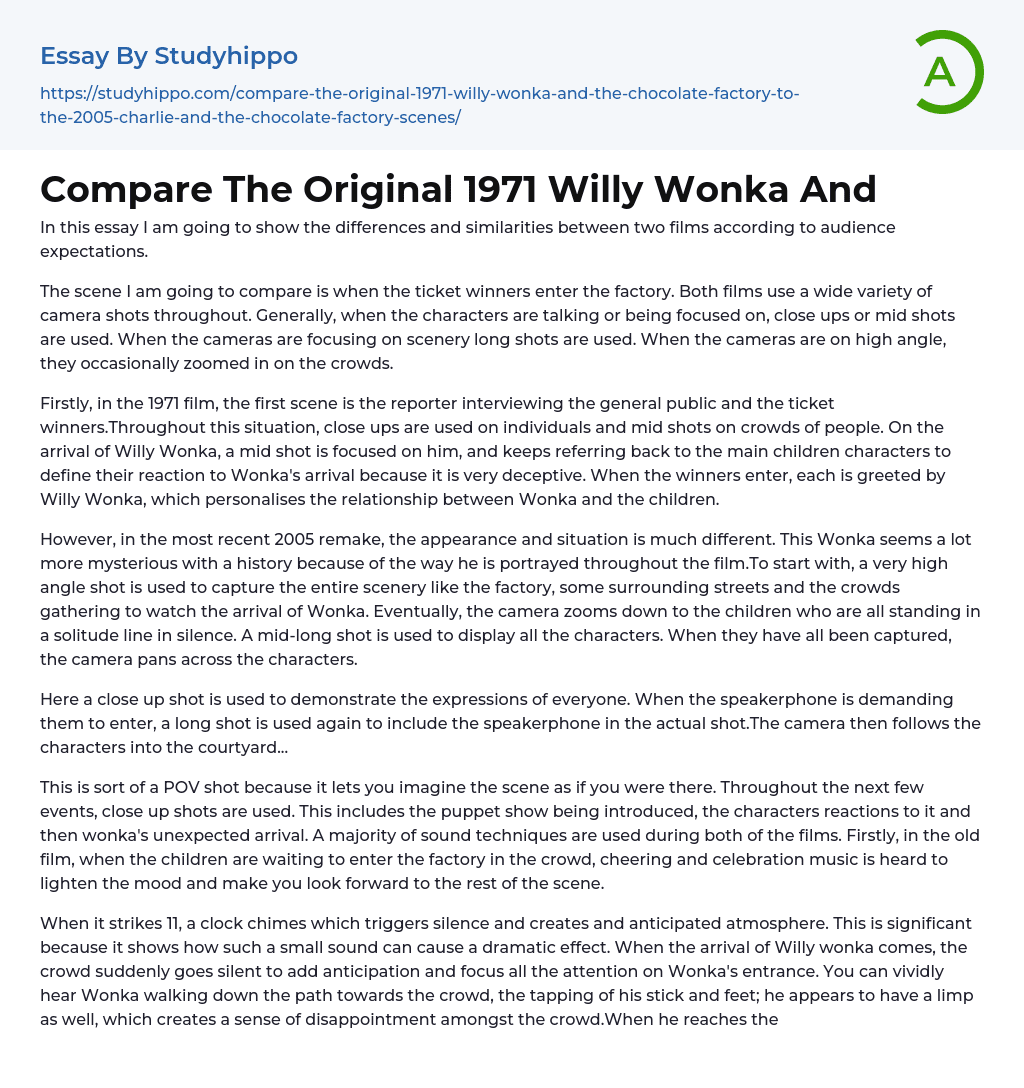The purpose of this essay is to compare and contrast two films based on the expectations of the viewers.
In comparing the scenes of the ticket winners entering the factory in both films, a myriad of camera shots are utilized. Close ups and mid shots are used when characters are conversing or being emphasized, while long shots are used for scenery. Additionally, high angle shots at times feature zooms on the crowds.
In the 1971 film, the first scene features a reporter interviewing members of the general public and ticket winners. Close ups are used for individuals and mid shots for crowds of people. The arrival of Willy Wonka is captured through a mid shot, frequently cutting back to show the reactions of the main child characters to his arrival, as it is quite deceptive. Upon entering, each winner is personally greeted by Willy Wo
...nka, thus establishing a personalized relationship between him and the children.
In the 2005 remake of the film, Wonka appears more mysterious and has a deeper history. This is conveyed through various cinematic techniques. The opening shot presents a high angle view of the factory, surrounding streets, and crowds eagerly awaiting Wonka's arrival. As the camera zooms in, the children are depicted standing in silence in a solitary line. A mid-long shot showcases all the characters before the camera pans across them.
Close-up shots are employed to showcase the expressions of the characters as the speakerphone directs them to enter. Subsequently, a long shot is utilized to encompass the speakerphone within the actual shot. As the characters enter the courtyard, the camera tracks them accordingly.
This POV shot allows the viewer to imagine being
present in the scene. The subsequent events are depicted using close-up shots, such as the introduction of the puppet show and the characters' reactions to it, as well as Wonka's unexpected arrival. Both films utilize numerous sound techniques. In the old movie, for instance, the cheering and celebratory music can be heard when the children are waiting to enter the factory in a crowd, creating a lighthearted atmosphere that anticipates the rest of the scene.
At 11, a clock chimes, resulting in silence and an atmosphere of anticipation - a small sound with a dramatic effect. When Willy Wonka arrives, the crowd falls silent, intensifying the focus on his entrance. The sound of Wonka walking down the path - tapping his stick and feet - is vividly audible. It appears he has a limp, disappointing the crowd. As he reaches the gates where the crowd awaits, Wonka drops to the ground and rolls over before standing up to the sound of cheers.
The recent film creates a chilling atmosphere through the use of sound techniques. The crowd remains silent with only a few individuals whispering, and the opening of the gates creates a creepy creaking noise. Wonka's voice echoes around the courtyard, emphasizing its importance and drawing attention to it. Despite featuring the same characters, their personalities and appearances differ between the two films. For instance, in the modern version, Violet appears more arrogant and obnoxious, and she matches her outfit with her mother's, heightening their resemblance.
As the main character, Willy Wonka plays a crucial role in the production. However, his character undergoes changes in the films. In the first film, he initially comes across as
warm and welcoming towards the children, but gradually deceives them. In contrast, the newer version portrays him as strange and mysterious from the beginning, creating an uneasy impression that he may be responsible for the other characters. The newer film's character traits are more pronounced and justified to their roles. Despite this, I believe that the older version's techniques are superior because in the newer film, a false atmosphere is introduced too early for younger audiences who may prefer a happier and more welcoming start before building towards the climaxes expected of a children's film.
- Boo Radley essays
- Genesis essays
- Richard iii essays
- Alice in Wonderland essays
- On the road essays
- Ozymandias essays
- The Nightingale essays
- Holden Caulfield essays
- Animal Farm essays
- 1984 essays
- A Hanging essays
- Shooting An Elephant essays
- A Tale Of Two Cities essays
- Adventures Of Huckleberry Finn essays
- Arthur Conan Doyle essays
- Brave New World essays
- Characters In Hamlet essays
- Characters In Romeo And Juliet essays
- Desdemona essays
- Diary Of A Wimpy Kid essays
- First-Person Narrative essays
- Frankenstein essays
- Heart Of Darkness essays
- Jane Eyre essays
- Jay Gatsby essays
- King Duncan essays
- Librarian essays
- Little Red Riding Hood essays
- Lord Of The Flies essays
- Silas Marner essays
- The Cask Of Amontillado essays
- The Catcher In The Rye essays
- The Crucible essays
- The Handmaid's Tale essays
- The Reader essays
- Virgil essays
- Wuthering Heights essays
- Candide essays
- Castle essays
- J. D. Salinger essays
- Ulysses essays
- Ethan Frome essays
- In Cold Blood essays
- Outliers essays
- Tuesdays With Morrie essays
- The Art of War essays
- Wife of Bath essays
- Huckleberry Finn essays
- The Lady With The Dog essays
- Great Expectations essays




